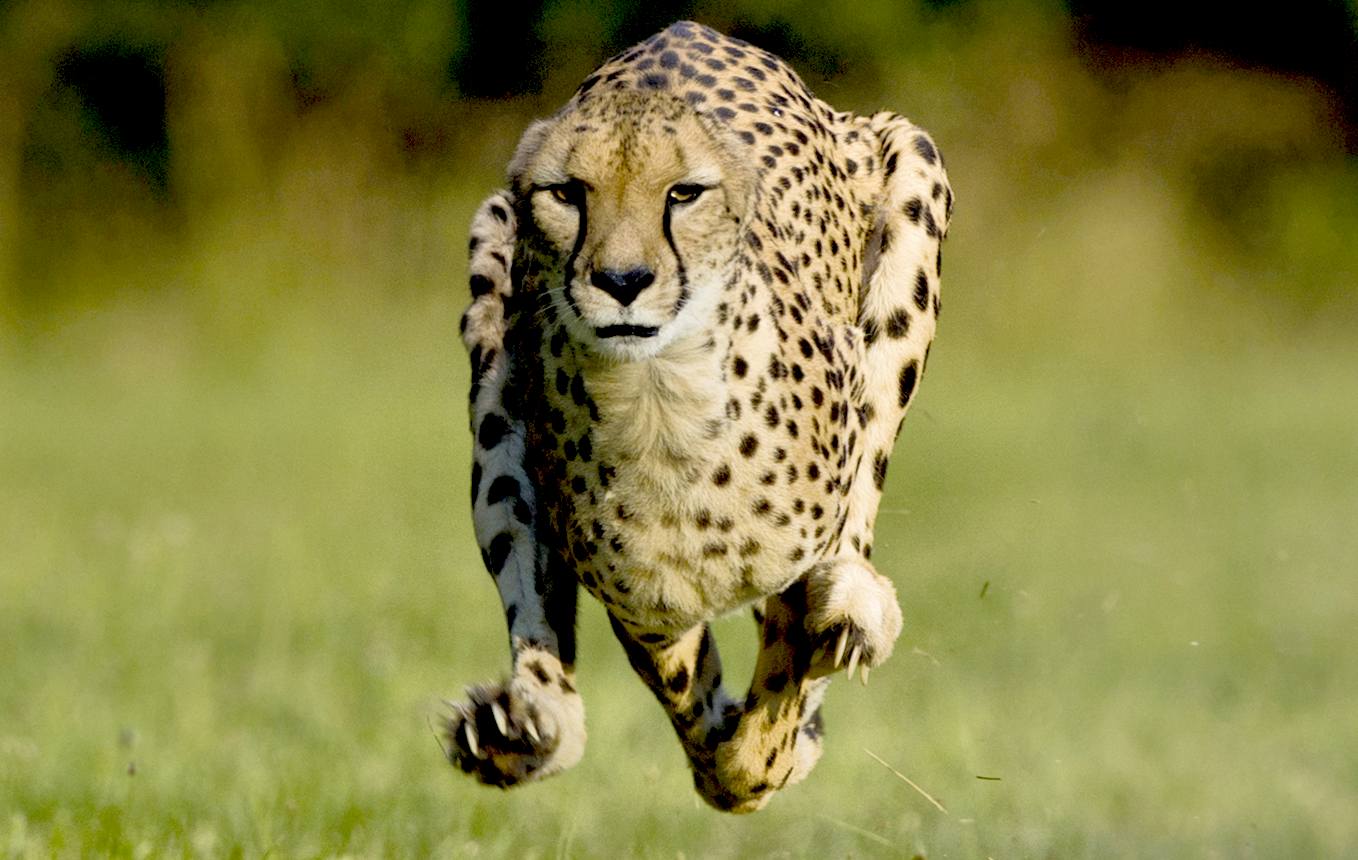|

The cheetah can run as fast as 109.4 to 120.7 km/h (68.0 to 75.0 mph), faster than any other land animal. It covers distances up to 500 m (1,640 ft) in short bursts, and can accelerate from 0 to 96 km/h (0 to 60 mph) in three seconds.
The
cheetah
can run as fast as 109.4 to 120.7 km/h (68.0 to 75.0 mph), faster than
any other land animal. It covers distances up to 500 m (1,640 ft) in
short bursts, and can accelerate from 0 to 96 km/h (0 to 60 mph) in
three seconds. It can do this because of an exceptionally well balanced design.
The cheetah (Acinonyx jubatus) is a big cat in the subfamily Felinae that inhabits most of Africa and parts of Iran. It is the only extant member of the genus
Acinonyx.
The cheetah's closest extant relatives are the puma and jaguarundi of the Americas. Cheetahs are notable for adaptations in the paws as they are one of the few felids with only semi-retractable claws.
Their main hunting strategy is to trip swift prey such as various antelope species and hares with its dewclaw. Almost every facet of the cheetah's anatomy has evolved to maximise its success in the chase, the result of an evolutionary arms race with its prey. Due to this specialisation, however, the cheetah is poorly equipped to defend itself against other large predators, with speed being its main means of defence.
In the wild, the cheetah is a prolific breeder, with up to nine cubs in a litter. The majority of cubs do not survive to adulthood, mainly as a result of depredation from other predators. The rate of cub mortality varies from area to area, from 50% to 75%, and in extreme cases such as the Serengeti ecosystem, up to 90%. Cheetahs are notoriously poor breeders in captivity, though several organizations, such as the De Wildt Cheetah and Wildlife Centre, have succeeded in breeding high numbers of cubs.
The cheetah is listed as vulnerable, facing various threats including: loss of habitat and prey; conflict with humans; the illegal pet trade; competition with and predation by other carnivores; and a gene pool with very low variability. It is a charismatic species and many captive cats are "ambassadors" for their species and wildlife conservation in general.
THE
FASTEST ANIMAL ON EARTH
Cheetahs are only "the fastest animal" if you restrict your search to land animals running from Point A to Point B. In which
case cheetahs can hit speeds up to 29 meters per second (or about 64 miles per hour).
But that figure requires a little context. Cheetahs run to catch dinner,
and most prey are smart enough not to bet their life on a drag race. Instead, they zig-zag. And that means that while cheetahs are capable of reaching 29 m/s under ideal test conditions, in the wild they average only 15 m/s (33 mph) and maintain that speed for just one to two seconds.
They have a relatively low acceleration and thus take a long duration to achieve their impressive
speeds.
The
fastest animal on land pro-rata, is the tiger beetle. If a tiger beetle
were the size of a cheetah or a man, it would be capable of sprinting at
700 miles per hour. Humans can only
run a little over 20mph and not for long.
IN
WATER
Another animal often included in the "fastest" conversation is the sailfish. These large billed
fish (the same family as marlins and swordfish) have been known to reach speeds of about 30 m/s (68 mph) when they breach the waves, though like the cheetah their normal cruising speed is closer to half that.
They have evolved special tissues that heat up their eyeball nerves so they can process images at "race-car speed and
precision.
IN
THE AIR
But neither land nor sea creature can hold a candle to the falcon, lord of air. When hunting, falcons climb to extraordinary heights and then use the force of gravity to plummet down toward prey like a meteor with talons.
In one study, a gyrfalcon named Kumpan was found to accelerate to speeds between 52 and 58 m/s (~116 and 129 mph) after free-falling from a height of 500 meters (~1640 feet). Another experiment by National Geographic clocked a peregrine falcon at nearly 82 m/s (183 mph), though this bird was taxied up to 4,572 meters (15,000 feet) in a plane before its record-breaking dive.
LINKS:
http://www.fastcompany.com/3040131/superlatives-week/the-fastest-animal-on-earth-is-not-a-cheetah
http://cheetah.org/about-the-cheetah/for-kids/
http://animals.nationalgeographic.com/animals/mammals/cheetah/
https://en.wikipedia.org/wiki/Cheetah
OTHER
ANIMALS:
|
AMPHIBIANS |
Such
as frogs (class: Amphibia) |
|
ANNELIDS |
As
in Earthworms (phyla: Annelida) |
|
ANTHROPOLOGY |
Neanderthals,
Homo Erectus (Extinct) |
|
ARACHNIDS |
Spiders
(class: Arachnida) |
|
ARTHROPODS |
Crabs,
spiders, insects (phyla: Arthropoda) |
|
BIRDS
|
Such
as Eagles, Albatross
(class: Aves) |
|
CETACEANS
|
such
as Whales
& Dolphins
( order:Cetacea) |
|
CRUSTACEANS |
such
as crabs (subphyla: Crustacea) |
|
DINOSAURS
|
Tyranosaurus
Rex, Brontosaurus (Extinct) |
|
ECHINODERMS |
As
in Starfish (phyla: Echinodermata) |
|
FISH
|
Sharks,
Tuna (group: Pisces) |
|
HUMANS
- MAN |
Homo
Sapiens THE
BRAIN |
|
INSECTS |
Ants,
(subphyla: Uniramia class:
Insecta) |
|
LIFE
ON EARTH
|
Which
includes PLANTS
non- animal life |
|
MAMMALS
|
Warm
blooded animals (class: Mammalia) |
|
MARSUPIALS |
Such
as Kangaroos
(order: Marsupialia) |
|
MOLLUSKS |
Such
as octopus (phyla: Mollusca) |
|
PLANTS |
Trees
- |
|
PRIMATES |
Gorillas,
Chimpanzees
(order: Primates) |
|
REPTILES |
As
in Crocodiles,
Snakes (class: Reptilia) |
|
RODENTS |
such
as Rats, Mice (order: Rodentia) |
|
SIMPLE
LIFE FORMS
|
As
in Amoeba, plankton (phyla: protozoa) |
|
|
POPULAR
MAMMALS:
|
